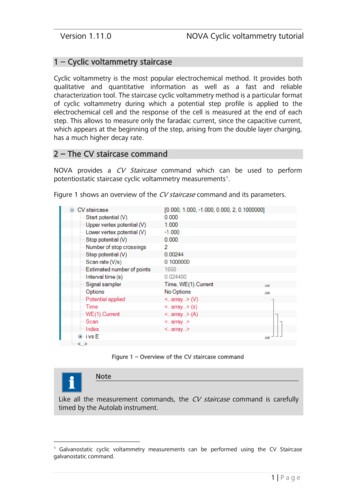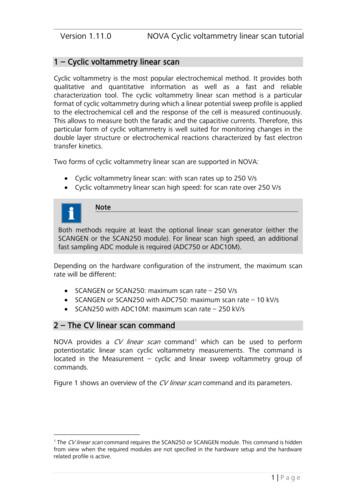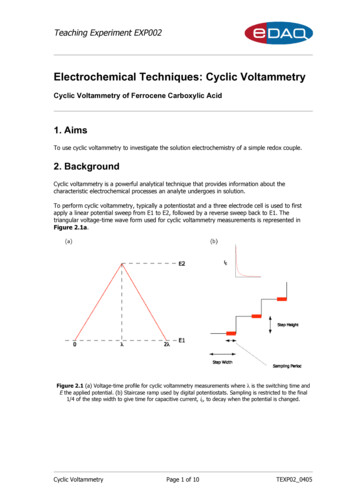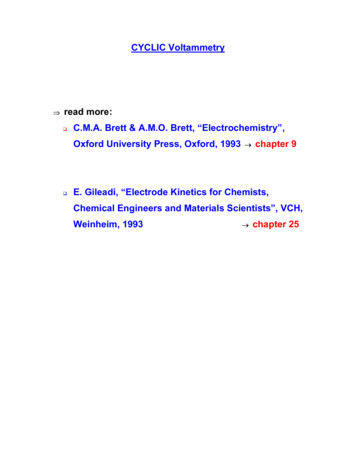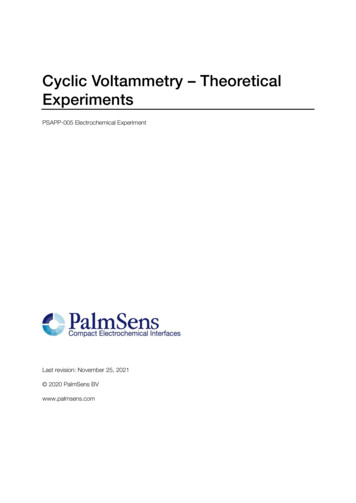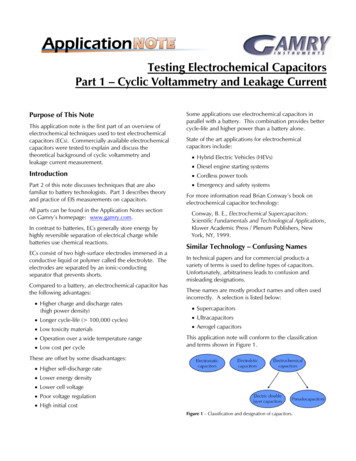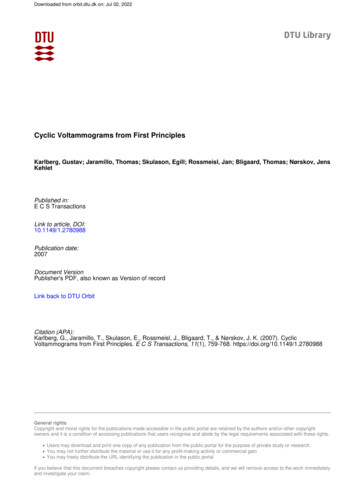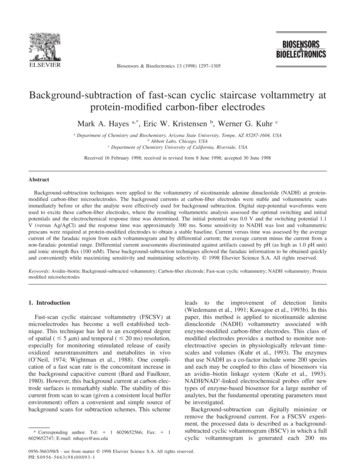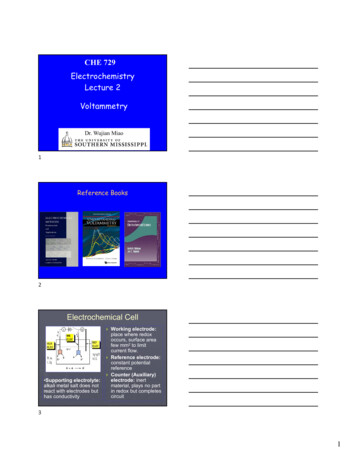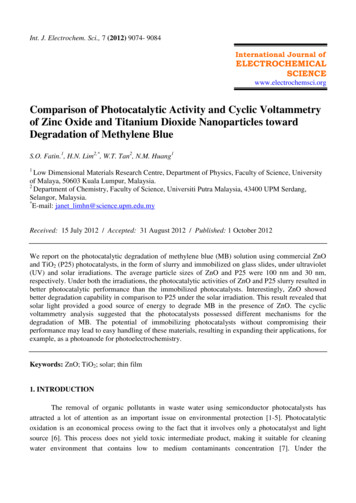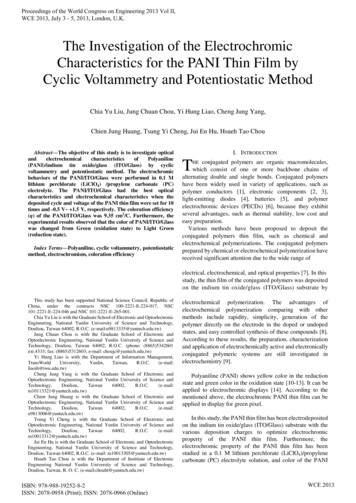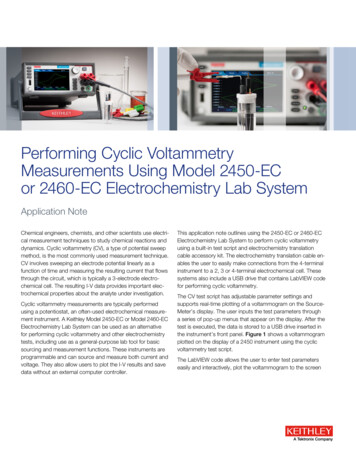
Transcription
Performing Cyclic VoltammetryMeasurements Using Model 2450-ECor 2460-EC Electrochemistry Lab SystemApplication NoteChemical engineers, chemists, and other scientists use electrical measurement techniques to study chemical reactions anddynamics. Cyclic voltammetry (CV), a type of potential sweepmethod, is the most commonly used measurement technique.CV involves sweeping an electrode potential linearly as afunction of time and measuring the resulting current that flowsthrough the circuit, which is typically a 3-electrode electrochemical cell. The resulting I-V data provides important electrochemical properties about the analyte under investigation.Cyclic voltammetry measurements are typically performedusing a potentiostat, an often-used electrochemical measurement instrument. A Keithley Model 2450-EC or Model 2460-ECElectrochemistry Lab System can be used as an alternativefor performing cyclic voltammetry and other electrochemistrytests, including use as a general-purpose lab tool for basicsourcing and measurement functions. These instruments areprogrammable and can source and measure both current andvoltage. They also allow users to plot the I-V results and savedata without an external computer controller.This application note outlines using the 2450-EC or 2460-ECElectrochemistry Lab System to perform cyclic voltammetryusing a built-in test script and electrochemistry translationcable accessory kit. The electrochemistry translation cable enables the user to easily make connections from the 4-terminalinstrument to a 2, 3 or 4-terminal electrochemical cell. Thesesystems also include a USB drive that contains LabVIEW codefor performing cyclic voltammetry.The CV test script has adjustable parameter settings andsupports real-time plotting of a voltammogram on the Source Meter’s display. The user inputs the test parameters througha series of pop-up menus that appear on the display. After thetest is executed, the data is stored to a USB drive inserted inthe instrument’s front panel. Figure 1 shows a voltammogramplotted on the display of a 2450 instrument using the cyclicvoltammetry test script.The LabVIEW code allows the user to enter test parameterseasily and interactively, plot the voltammogram to the screen
Application NoteThe following procedure can be used toperform a measurement for each point inthe scan, E(i):Electrochemical rode1.Select a potential (E) for REwith respect to WE.2.Adjust the voltage across the entirecell (CE to WE) to get desired E(closed loop control).3.Measure i.4.Figure 1. 2450-EC system plotting a voltammogram.in real time, and save the results to the computer in a .csv file.For users that don’t have LabVIEW available, the USB driveincludes a LabVIEW Run-Time application for performing theCV test from a PC. Figure 2 shows the LabVIEW applicationfor cyclic voltammetry. The code also allows taking continuousopen-circuit voltage measurements.Select (step) a new E and repeatprocedure until the scan is finished.The procedure can be a singlesweep between two potentials. If this is the case, this iscalled linear sweep voltammetry. The procedure may alsobe configured that when a certain potential is reached, thesweep is inverted. This is called cyclic voltammetry. Thiscycle may be repeated multiple times during an experiment.5. Plot the results and derive parameters of interestfrom the data.3-ElectrodeElectrochemical CellSimplifiedCircuitCEREAdjustableVSWEVMEFigure 2. LabVIEW application for cyclic voltammetry.The Basics of Cyclic VoltammetryFigure 3 illustrates a typical electrochemical measurementcircuit made up of an electrochemical cell, an adjustable voltage source (VS), an ammeter (AM), and a voltmeter (VM). Thethree electrodes of the electrochemical cell are the workingelectrode (WE), reference electrode (RE), and the counter(or auxiliary) electrode (CE). The voltage source (VS) for thepotential scan is applied between the working electrode andthe counter electrode. The potential (E) between the referenceelectrode and the working electrode is measured with the voltmeter, and the overall voltage (Vs) is adjusted to maintain thedesired potential at the working electrode with respect to thereference electrode. The resulting current (i) flowing to or fromthe working electrode is measured with the ammeter (AM). Thisprocess is usually repeated for a range of E.2www.keithley.comAMiFigure 3. Simplified measurement circuit for performing cyclic voltammetry.Once the experiment is complete, the measured current isplotted as a function of the potential in a graph known asa voltammogram. The example voltammogram in Figure 4shows four voltage vertices: E1 (initial potential), E2 (second,switching potential), E3 (third, switching potential), and E4 (finalpotential). The voltage peaks in the waveform are the anodic(Epa) and the cathodic (Epc) peak potentials. In this example,the scan begins at E1 and the potential becomes increasingmore positive causing the anodic current to rise rapidly andpeak at the anodic peak potential (Epa). At E2, the scan direction switches to negative for the reverse scan. As the currentbecomes more negative, cathodic current will flow as the electrode process is reduced. A cathodic peak potential occurs at
Performing Cyclic Voltammetry Measurements Using 2450-EC or 2460-EC Electrochemistry Lab SystemEpc. At the third potential, E3, the direction is reversed againand the voltage is swept until it reaches E4. From the potentialsweep, important information about the experiment can bederived and analyzed.1.E-03Epa8.E-046.E-04OxidationCurrent (A)4.E-04E1, E4E22.E-040.E 300.10.20.30.40.50.6Potential (V)0.70.80.91Figure 4. Example voltammogram generated using Model 2450-EC system.Using the 2450-EC or 2460-ECSystems to Perform Cyclic VoltammetryFollow these steps to perform cyclic voltammetry testing usingthe 2450-EC or 2460-EC Systems and the CyclicVoltammetrytest script.Make Connections from the 4-TerminalSourceMeter to the 3-Electrode CellTo perform cyclic voltammetry the instrument is set up to forcevoltage and measure current in a 4-wire (remote sense) configuration. The four terminals of the instrument are connectedto the 3-electrode electrochemical cell, as shown in Figure 5.SourceMeterCounterElectrodeForce LOSense eVSWorkingElectrodeVM Sense HIAMForce HIi Figure 5. Connecting an electrochemistry lab system to an electrochemicalcell for cyclic voltammetry.The Force HI and Sense HI terminals are connected to theworking electrode. At this terminal, the voltage is forced andthe current is measured from the working electrode to thecounter electrode. The Sense LO terminal is connected to thereference electrode. The Force LO terminal is connected to thecounter electrode. The instrument measures the voltage difference between the working and reference electrodes (betweenthe Sense HI and Sense LO terminals) and ensures the voltageis kept constant.When the instrument is programmed to source voltage inthe remote sense configuration, internal sensing providesa feedback voltage that is measured and compared to theprogrammed voltage level. If the feedback voltage is less thanthe programmed voltage level, then the voltage source isincreased until the feedback voltage equals the programmedvoltage level. Remote sensing compensates for the voltagedrop in the test leads and analyte, ensuring that the programmed voltage level is delivered to the working electrode.Download and Run the Test ScriptOnce the connections from the instrument to the cell aremade, the test script can be executed. The cyclic voltammetrytest script was created using TSP (Test Script Processing)code. TSP technology can embed complete test programsinside the instrument. Each instrument has an embeddedtest script processor, which allows executing test programs(scripts), without the use of an external computer. Any editor,such as Notepad or Keithley’s Test Script Builder software,can be used to edit a script.The CyclicVoltammetry script has been preloaded into theinstrument. The test script is executed by pressing the ActiveScript Indicator at the top of the instrument’s home screen,then touching the CyclicVoltammetry test script, as shownin Figure 6.Execute the Test ScriptOnce the test script begins to execute, the user must respondto prompts on the instrument’s touchscreen to define theparameters of the test.Acquire the Open Circuit Potential: During execution, themeasured open circuit potential (Eoc) is displayed and theuser must respond if the value is acceptable. The open circuitpotential of the electrochemical cell is measured while theinstrument is in the voltmeter mode. When the open circuitpotential is measured, the current source is set to output 0A.This high impedance voltage measurement is made using theinstrument in a 4-wire configuration as shown in Figure 7. It’sunnecessary to change any test leads manually.This Eoc potential measurement can be used as the reference measurement when defining a voltage vertex. If this is thecase, then the Eoc measurement gets added to that vertex.www.tektronix.com3
Application NoteThe voltage magnitude in the range of 5.0000V must be specified for eachvertex potential. The user must alsochoose if the applied potential at eachvertex is vs. the reference potential (Eref)or the open circuit potential (Eoc).Electrochemical CellWorkingElectrodeReferenceElectrodeSelect the Scan Rate: Next, the scanrate is specified from a range of 0.1mV/s to 3500 mV/s. The scan rate defines the rate at which the potential willbe linearly swept during the experiment.CounterElectrodeThe CyclicVoltammetry script executes whenit is pressed on the touchscreen displayThe instrument does not output a trulylinear voltage; instead, it outputs verysmall digitized steps from 0.1mV to10mV, depending upon the scan rate. These voltage step sizes are used during scanning based on the user-set scan rate:Figure 6. Executing the CyclicVoltammetry test script from the home screen of the 2460 instrument.Define the Voltage Vertices: After the open circuit voltageis measured, the voltages of the potential sweep must bedefined, which includes the number of vertices, the voltagemagnitude, and the reference voltage. The user can select upto four voltage vertices, which are defined as E1 (or E initial),E2, E3, and E4; these vertices are shown in the potential vs.time plot in Figure 8. The slope of the lines provides the scanrate that is used in the sweep. 100µV Step Size: 0.1mV/s scan rate 35mV/s 1mV Step Size: 35mV/s scan rate 350mV/s 10mV Step Size: 350mV/s scan rate 3500mV/sSelect the Number of Cycles: The number of cycles selected(from 1 to 100) determines how many times each scan will berepeated. Figure 9 shows an example of a potential vs. timegraph showing three cycles of a three-vertex voltage scan.Model 2450 or 2460SourceMeterForce LOSense LO3-ElectrodeElectrochemicalCellRE0AVMEocPotential (V)CEE2E1E2E2E1/E3E1/E3E3WETime (s)Figure 9. Graph of a three-cycle, three-vertex voltage scan.Sense HIForce HIFigure 7. Instrument configuration for measuring the open circuit potential ofPotential (V)an electrochemical cell.E2E1E4E3Time (s)Figure 8. Potential sweep vs. time of cyclic voltammetry example.4www.keithley.comChoose a Current Measurement Range: During the scan,the current is measured on a user-specified range. The selectable current ranges will vary depending on whether the 2450EC or 2460-EC System is being used. The current ranges forthe 2450-EC are the 10µA, 100µA, 1mA, 10mA, 100mA, and1A ranges. The current ranges for the 2460-EC are the 1mA,10mA, 100mA, 1A, 4A, 5A, and 7A ranges.
Performing Cyclic Voltammetry Measurements Using 2450-EC or 2460-EC Electrochemistry Lab SystemAcquire Readings by Sampling Interval Units: During thescan, many small voltage steps are output and the resultingcurrent is measured. To limit the number of points (current,voltage, and time readings) returned to the internal buffer, theuser can define how often to store readings into the defaultbuffer by specifying one of the eight Sampling Interval Units.Table 1 describes each of the Sampling Interval Units alongwith a range of values.Table 1. Sampling Interval Units.SamplingInterval UnitDescriptionRange of Valuespts/testThe total number of points acquiredduring a test regardless of howmany cycles10 to 10,000pts/cycleThe total number of points acquired ineach cycle10 to 10,000sec/ptsThe number of seconds per each point0.01 to 100pts/secThe total number of points takenper second0.01 to 100mV/ptThe number of millivolts between points0.1 to 1000pts/mVThe number of points per millivolt0.001 to 10mA/ptThe number of milliampsbetween points0.0001 to 100pts/mAThe number of points per milliamp0.01 to 10,000Generate the Scan and View the Graph in Real Time: Onceall the inputs have been defined, the experiment begins. Thegeneration of the voltammogram can be viewed in real time onthe Graph screen. The graphs are plotted using the IUPAC (International Union of Pure and Applied Chemistry) convention,in which potentials become more positive along the x-axis.Anodic current is shown as positive on the y-axis, and thecathodic current is shown as negative on the y-axis.Figure 10. Voltammogram generated by 2450-EC from the Fe(CN) experiment.Another example experiment was performed on copper sulfateusing the CyclicVoltammetry test script. In this example,cyclic voltammetry was used to plate copper on a graphiteworking electrode and then strip it back again. This chemicalreaction was:(reduction) Cu2 2e– Cu (metallic)(oxidation) Cu Cu2 2e–In this test, three voltage vertices were configured so the voltage was swept from 0.4V –0.1V 0.4V using a scan rateof 25mV/s. The Sampling Interval Unit was set to 5 points/s.Three cycles of the scan were performed and the results ofthis experiment are shown in Figure 11.The voltammogram generated by the instrument shownin Figure 10 is a result of the following reversible chemicalreaction of potassium ferricyanide K3[Fe(CN)6]:(oxidation) FeII(CN)64– FeIII(CN)63– e–(reduction) FeIII(CN)63– e– FeII(CN)64–Figure 11. Voltammogram generated by 2450-EC for the copper sulfateexperiment.In this example, four voltage vertices and a scan rate of25mV/s were used to generate this voltammogram, whichcontains data from three cycles.www.tektronix.com5
Application NoteView the Results in the Data in the .CSV File: If the data issaved to the USB drive, the readings can be viewed by opening the file in a spreadsheet on a computer. Figure 12 illustrates an example of how the data appears. In addition to thecurrent, voltage, and time, general parameters about the testare included in the file.General Parameters:EOC potential 0.215446 VfileName fecn23test7Source Parameters:Source Range # of Vertices Vertex 1 Vertex 2 Vertex 3 Vertex 4 Source Rate # of Cycles Measure Parameters:Current Range Sampling Interval Calculated ParametersstepSize sourceDelay sec0.1 A2 pts/secFigure 12. Example data as it appears in a .csv file.www.keithley.comThe 2450-EC and 2460-EC include a LabVIEW project forperforming cyclic voltammetry and open circuit potential measurements. This option includes the LabVIEW source code toperform CV, as well as a LabVIEW Run-Time application toperform cyclic voltammetry from a PC for those using systemswithout LabVIEW installed.Before executing the LabVIEW code, the 2450 or 2460instrument must be connected to the PC via a communicationinterface, either GPIB, USB, or Ethernet. Once connected, users can easily input the source and measure test parameters(scan rate, voltage source and reference values, number ofcycles, measurement range, sampling interval units, etc.) in theSource Settings and Measure Settings windows of the LabVIEW application. After the CV test is configured, all it takesto execute the test is a touch of the Start button. The voltammogram is plotted in real time on the Graph tab. The current,voltage and time measurements are listed in real time in theResults tab, as shown in Figure 13. This data, along with thetest parameters, can be saved to the computer in a .csv file.The open circuit voltage (Eoc) can also be monitored independently of the cyclic voltammetry scan.0.0001 V0.004 seconds0.55 060.22795 0.4791990.001817730.24045 0.9791920.002609120.25295 1.479210.003283550.26545 1.979190.003830690.27795 2.479190.004233510.290452.97920.004477140.30295 3.479210.004561080.31545 3.979190.004508990.32795 4.479186Using the LabVIEW Project and LibraryFigure 13. Keithley cyclic voltammetry LabVIEW Project GUI.
Performing Cyclic Voltammetry Measurements Using 2450-EC or 2460-EC Electrochemistry Lab SystemConclusionThe 2450-EC and 2460-EC Electrochemistry Lab Systemsare ideal tools for performing common electrochemistrytests. These systems include test scripts for performing cyclicvoltammetry, open circuit potential measurements, potentialpulse and square wave with current measurements, currentpulse and square wave with potential measurements, chronoamperometry, and chronopotentiometry. These systemsexecute the tests without the use of a computer. An electrochemistry translation cable is also included to make easyconnections between the instrument and an electrochemicalcell. A USB flash drive that contains LabVIEW code to performcyclic voltammetry is included, along with the source code forthe test scripts.Cyclic Voltammetry Test Settable Values: Potential Range: 5V Voltage Step Size During Ramping:–– 100µV (0.1mV/s scan rate 35mV/s )–– 1mV (35mV/s scan rate 350mV/s )–– 10mV (350mV/s scan rate 3500mV/s Scan Rate: 0.1mV/s to 3500mV/s Current Measurement Range (full scale):–– 2450-EC: 100µA, 1mA, 10mA, 100mA, 1A–– 2460-EC: 1mA, 10mA, 100mA, 1A, 4A, 5A, 7A Number of Cycles: 1 to 100 User Selectable Sampling Interval Units: Points/Test, Points/Cycle, Seconds/Point, Points/Second, mV/Point, Points/mV, mA/Point, Points/mA Maximum Number of Points: up to 100,000 readingswww.tektronix.com7
Contact Tektronix and Keithley:ASEAN / Australasia (65) 6356 3900Austria 00800 2255 4835Balkans, Israel, South Africa and other ISE Countries 41 52 675 3777Belgium 00800 2255 4835Brazil 55 (11) 3759 7627Canada 1 800 833 9200Central East Europe and the Baltics 41 52 675 3777Central Europe & Greece 41 52 675 3777Denmark 45 80 88 1401Finland 41 52 675 3777France 00800 2255 4835Germany 00800 2255 4835Hong Kong 400 820 5835India 000 800 650 1835Italy 00800 2255 4835Japan 81 (3) 6714 3010Luxembourg 41 52 675 3777Mexico, Central/South America & Caribbean 52 (55) 56 04 50 90Middle East, Asia, and North Africa 41 52 675 3777The Netherlands 00800 2255 4835Norway 800 16098People’s Republic of China 400 820 5835Poland 41 52 675 3777Portugal 80 08 12370Republic of Korea 001 800 8255 2835Russia & CIS 7 (495) 6647564South Africa 41 52 675 3777Spain 00800 2255 4835Sweden 00800 2255 4835Switzerland 00800 2255 4835Taiwan 886 (2) 2656 6688United Kingdom & Ireland 00800 2255 4835USA 1 800 833 9200Rev. 11/15For Further InformationTektronix and Keithley maintain a comprehensive, constantly expanding collectionof application notes, technical briefs and other resources to help engineersworking on the cutting edge of technology. Please visit www.tektronix.com andwww.keithley.com.Copyright 2015, Tektronix. All rights reserved. Tektronix products arecovered by U.S. and foreign patents, issued and pending. Information in thispublication supersedes that in all previously published material. Specificationand price change privileges reserved. TEKTRONIX and TEK are registeredtrademarks of Tektronix, Inc. All other trade names referenced are the servicemarks, trademarks or registered trademarks of their respective companies.11215 KI 1KW-60116-0
for cyclic voltammetry. The code also allows taking continuous open-circuit voltage measurements. Figure 2. LabVIEW application for cyclic voltammetry. The Basics of Cyclic Voltammetry Figure 3 illustrates a typical electrochemical measurement circuit made up of an electrochemical cell, an adjustable volt-age source (V S), an ammeter (A M
